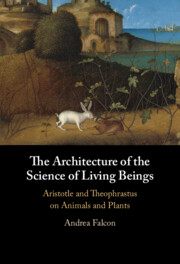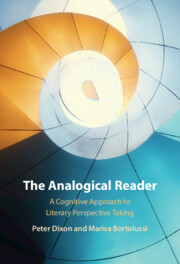108 results
Chapter 3 - Pre-explanatory and Explanatory Strategies in Aristotle’s Study of Animals
-
- Book:
- The Architecture of the Science of Living Beings
- Published online:
- 30 May 2024
- Print publication:
- 06 June 2024, pp 77-120
-
- Chapter
-
- You have access
- Open access
- HTML
- Export citation
Chapter 5 - Theophrastus on the Generation of Plants (Causes of Plants I)
-
- Book:
- The Architecture of the Science of Living Beings
- Published online:
- 30 May 2024
- Print publication:
- 06 June 2024, pp 152-186
-
- Chapter
-
- You have access
- Open access
- HTML
- Export citation
Chapter 6 - The Invention of Biology?
-
- Book:
- The Architecture of the Science of Living Beings
- Published online:
- 30 May 2024
- Print publication:
- 06 June 2024, pp 187-208
-
- Chapter
-
- You have access
- Open access
- HTML
- Export citation
Chapter 6 - Generative Intelligence
- from Part II - Transition Expertise
-
- Book:
- Transition Expertise and Identity
- Published online:
- 30 May 2024
- Print publication:
- 06 June 2024, pp 92-109
-
- Chapter
- Export citation
Chapter 4 - The Transition from the Study of Animals to the Study of Plants (History of Plants I)
-
- Book:
- The Architecture of the Science of Living Beings
- Published online:
- 30 May 2024
- Print publication:
- 06 June 2024, pp 121-151
-
- Chapter
-
- You have access
- Open access
- HTML
- Export citation

The Architecture of the Science of Living Beings
- Aristotle and Theophrastus on Animals and Plants
-
- Published online:
- 30 May 2024
- Print publication:
- 06 June 2024
-
- Book
-
- You have access
- Open access
- Export citation
Chapter 2 - Exalting Eros
-
- Book:
- Neoplatonic Pedagogy and the Alcibiades I
- Published online:
- 16 May 2024
- Print publication:
- 23 May 2024, pp 28-74
-
- Chapter
- Export citation
Chapter 9 - Epicureans on Preconceptions and Other Concepts
-
-
- Book:
- Conceptualising Concepts in Greek Philosophy
- Published online:
- 25 April 2024
- Print publication:
- 02 May 2024, pp 203-236
-
- Chapter
- Export citation
Introduction
-
- Book:
- Three Faces of Sun Tzu
- Published online:
- 07 March 2024
- Print publication:
- 15 February 2024, pp 1-22
-
- Chapter
- Export citation
Introduction
-
- Book:
- Three Faces of Sun Tzu
- Published online:
- 07 March 2024
- Print publication:
- 15 February 2024, pp 1-22
-
- Chapter
- Export citation
A cross-cultural archery analogy in Matteo Ricci's Tianzhu shiyi
-
- Journal:
- Bulletin of the School of Oriental and African Studies / Volume 87 / Issue 1 / February 2024
- Published online by Cambridge University Press:
- 10 January 2024, pp. 201-207
- Print publication:
- February 2024
-
- Article
- Export citation
A Harrean perspective of theology
-
- Journal:
- Religious Studies , First View
- Published online by Cambridge University Press:
- 03 January 2024, pp. 1-13
-
- Article
-
- You have access
- Open access
- HTML
- Export citation
2 - Context in Historical Linguistics
- from Part I - Language in Context: A Sociohistorical Perspective
-
-
- Book:
- The Cambridge Handbook of Language in Context
- Published online:
- 30 November 2023
- Print publication:
- 14 December 2023, pp 49-70
-
- Chapter
- Export citation
Chapter 5 - Processing Components of Perspective Taking
-
- Book:
- The Analogical Reader
- Published online:
- 09 November 2023
- Print publication:
- 23 November 2023, pp 122-150
-
- Chapter
- Export citation
7 - Islam
-
- Book:
- Learning from Other Religions
- Published online:
- 30 October 2023
- Print publication:
- 16 November 2023, pp 260-309
-
- Chapter
- Export citation

The Analogical Reader
- A Cognitive Approach to Literary Perspective Taking
-
- Published online:
- 09 November 2023
- Print publication:
- 23 November 2023
31 - Analogy and Extension
- from Part V - Explanatory Discussions
-
-
- Book:
- The Cambridge Handbook of Historical Orthography
- Published online:
- 28 September 2023
- Print publication:
- 12 October 2023, pp 617-643
-
- Chapter
- Export citation
9 - Language Acquisition
- from IV - Language Acquisition
-
- Book:
- A Mind for Language
- Published online:
- 13 October 2023
- Print publication:
- 21 September 2023, pp 293-336
-
- Chapter
- Export citation
Chapter 2 - Problem Solving
- from Part I - Cognition
-
- Book:
- Encouraging Innovation
- Published online:
- 17 August 2023
- Print publication:
- 31 August 2023, pp 16-26
-
- Chapter
- Export citation
Chapter 26 - Views on ‘Early Latin’ in Grammatical Texts
- from Part IV - Reception
-
-
- Book:
- Early Latin
- Published online:
- 27 July 2023
- Print publication:
- 17 August 2023, pp 527-548
-
- Chapter
- Export citation



